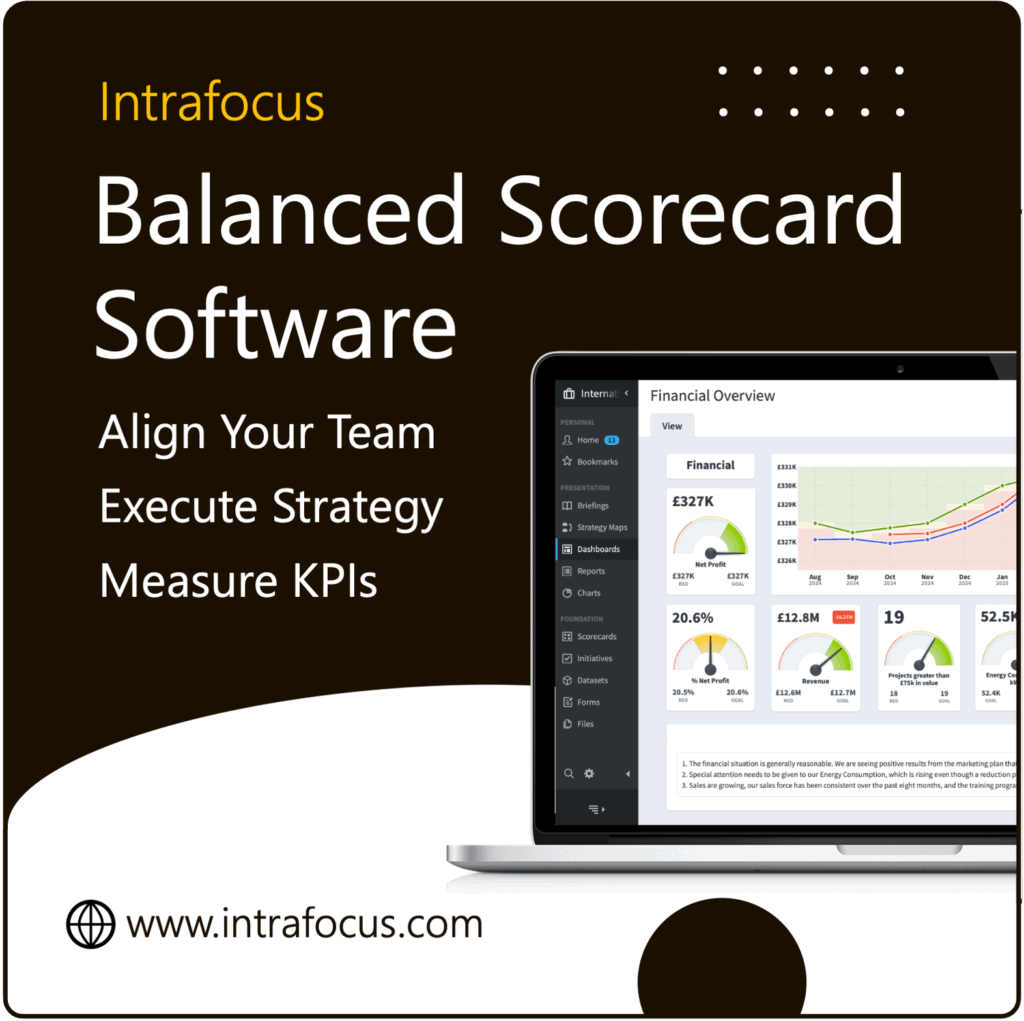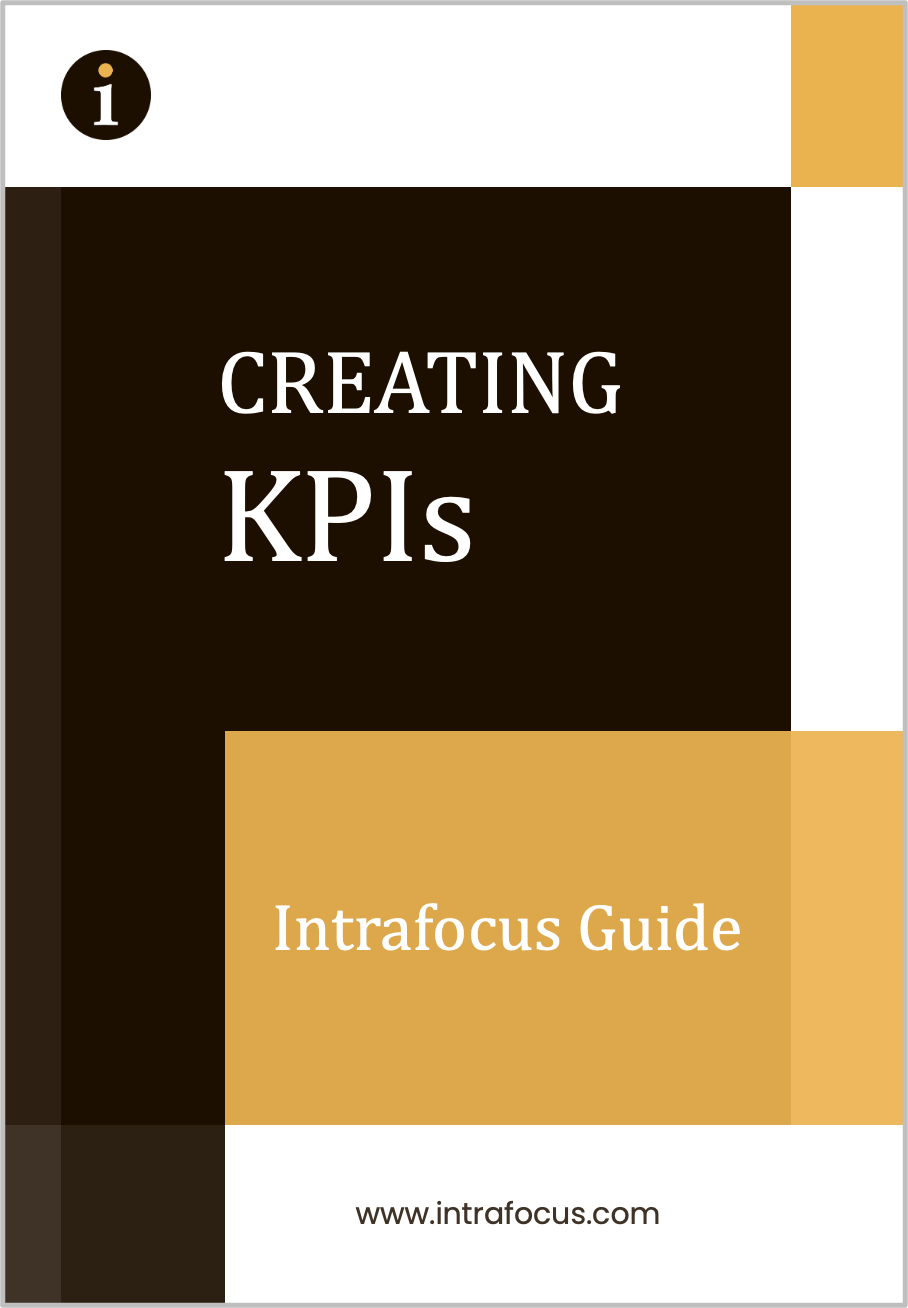Dashboards, spreadsheets, and reports often contain impressive numbers but say little about whether strategy is on track. Many businesses measure what is easy to find rather than what is important. They fall into the trap of collecting data simply because it is available, not because it tells them if they are achieving their long-term goals.
This is where the Balanced Scorecard provides real value. It ensures that performance measurement is anchored to strategy. Instead of drowning in metrics, leaders can focus on a carefully chosen set of key performance indicators (KPIs) that show whether their strategic objectives are being met.
Related: Balanced Scorecard software from Intrafocus — the official EMEA supplier of Spider Impact.
Choosing the right KPIs is critical. Too few, and you risk blind spots. Too many, and focus is lost. Let’s explore how to choose the right KPIs and metrics, how they fit within the Balanced Scorecard framework, and how tools such as AI can support the process.
KPIs and the Balanced Scorecard
Key performance indicators are more than just numbers on a report. They are the link between high-level strategy and day-to-day activity. A well-designed KPI answers the question: Are we making progress toward our strategic objectives?
In the Intrafocus Strategic Planning Process, KPIs appear in Step Four. The vision, priorities, and objectives are already defined by this stage. KPIs give those objectives measurable targets and make them real. Without KPIs, strategy remains abstract and difficult to monitor. Leaders can see progress, spot problems early, and make evidence-based decisions with them.
It is also important to distinguish between KPIs and ordinary measures. Operational metrics, such as daily output or number of calls answered, are useful but do not always reflect strategic progress. KPIs, by contrast, focus on outcomes that directly support long-term goals. For example, measuring customer retention is a KPI that indicates success in building loyalty, whereas counting the number of customer complaints is only an operational measure. The Balanced Scorecard helps organisations focus on this higher level of performance measurement.
Choosing the Right KPIs
Selecting the right KPIs is both art and science. It requires a clear understanding of the organisation’s strategy and the discipline to focus only on what truly matters. The following principles provide a framework for choosing wisely:
Alignment with strategic objectives: Every KPI must link directly to a specific objective. If the objective is to improve customer loyalty, then a relevant KPI might be the renewal rate or net promoter score. This alignment ensures that KPIs drive behaviour that supports strategy.
Balance between leading and lagging indicators: Lagging indicators, such as profit or market share, tell you what has already happened. Leading indicators, such as staff training hours or sales pipeline strength, provide early signals of future performance. A strong KPI set includes both types to give a rounded picture.
Ownership and accountability: Each KPI should have a named owner responsible for monitoring and reporting progress. Without ownership, KPIs lose meaning and accountability is diluted.
Keep the number practical: More is not better. A small, focused set of KPIs is easier to manage and keeps the organisation’s attention on what matters most.
Apply SMART criteria: KPIs should be specific, measurable, achievable, relevant, and time-bound. Vague measures such as “improve service” are not helpful; a KPI such as “increase customer satisfaction score from 70 to 80 within 12 months” is far more effective.
By applying these principles, organisations can avoid KPI overload and build a measurement system that supports clarity, alignment, and performance.
KPIs Across Four Perspectives
The Balanced Scorecard ensures that organisations do not measure performance from only one angle. By structuring KPIs across the four perspectives, leaders gain a balanced and connected view of progress. Each perspective should contain a small set of KPIs that link directly to strategic objectives.
Financial Perspective
Financial KPIs measure the ultimate outcomes of strategy. Examples include revenue growth, profit margin, return on investment, and cost-to-income ratio. These indicators show whether the organisation is delivering value to shareholders, investors, or funding bodies.
Customer Perspective
Customer KPIs reveal how well the organisation is meeting the needs and expectations of its clients. Satisfaction scores, retention rates, market share, and net promoter score (NPS) are common choices. Data analysis advances, including using AI to review customer feedback, can highlight new measures such as sentiment trends or brand trust indicators.
Internal Processes Perspective
These KPIs monitor the efficiency and effectiveness of core operations. Examples include cycle times, error rates, on-time delivery, and compliance with quality standards. Predictive analytics can also help here by identifying early signals of potential bottlenecks or quality issues, enabling leaders to act before problems escalate.
Organisational Capacity Perspective
This perspective, which Intrafocus defines as an update of the traditional “Learning and Growth,” focuses on the enablers of strategy. KPIs may include employee engagement, training hours per staff member, IT system uptime, or the number of innovations in the pipeline. AI can support this area by uncovering correlations between engagement scores and customer satisfaction, revealing insights that guide both people development and investment in systems.
These examples highlight that while technology can enhance how KPIs are discovered and monitored, the key principle remains alignment. Every KPI must link to a strategic objective. There is no universal list, only the right set for your organisation’s goals.
Avoiding The KPI Traps
Even with a sound framework, many organisations stumble when it comes to KPIs. Recognising and avoiding common traps is critical to success when choosing the right KPIs.
Measuring what is easy rather than what is important: Readily available data, such as website hits or hours worked, can be tempting. But these figures may not say anything about strategic progress.
KPI overload: Collecting dozens of measures creates confusion and dilutes focus. A concise set of well-chosen KPIs provides clarity and ensures teams know what to prioritise.
Over-reliance on lagging indicators: Financial results are vital, but they only show what has already happened. Without leading indicators, such as employee training or pipeline development, organisations risk being blindsided.
Inconsistent definitions: When KPIs are not clearly defined, people interpret them differently. This inconsistency makes reports unreliable and undermines decision-making.
Poor data quality: Manual collection is slow, error-prone, and often incomplete. Automation can resolve this by ensuring data is gathered consistently and reported in real time.
This is where technology supports better practice. Software such as Spider Impact automates the collection, calculation, and presentation of KPIs, reducing errors and freeing leaders to focus on interpretation and action. Combined with AI analysis, automation can highlight patterns across perspectives, helping organisations avoid blind spots and refine their KPI sets over time.
By steering clear of these traps and embracing modern tools, organisations can ensure their KPIs remain reliable, aligned, and useful in driving strategy forward.
Insights From Research and Industry Practice
While every organisation must define its own KPIs, it is helpful to learn from external research and industry practice. A Harvard Business Review article, Don’t Let Metrics Undermine Your Business, warns that focusing on the wrong numbers can derail strategy. It reinforces that metrics must serve strategic intent, not replace it.
At a structural level, the OECD’s 2023 Performance Budgeting Framework offers guidance on designing meaningful, outcome‑focused performance information. It emphasises tools and methods to craft indicators that drive behavior, while cautioning against overwhelming stakeholders with too many measures
By drawing on both academic insight and practical examples, organisations can strengthen their approach and avoid reinventing the wheel when designing effective KPIs.
How Intrafocus Helps You Define the Right KPIs
At Intrafocus, we have seen first-hand how the right KPIs can transform the way organisations manage strategy. Many leadership teams come to us with too many measures or metrics that reflect operational activity rather than long-term success. We help organisations clarify their priorities through workshops and consultancy support and define a concise set of KPIs that provide real strategic insight.
Our Seven-Step Strategic Planning Process is designed to make KPI selection straightforward. The path is set for Step Four: Key Performance Indicators by first defining vision, priorities, and objectives. At this point, leaders are ready to choose measures that align with strategy, avoiding the distractions of operational data.
We also support the process with technology. Spider Impact integrates objectives, KPIs, and initiatives into one platform. This makes reporting seamless, reliable, and accessible to everyone in the organisation, ensuring KPIs remain at the heart of performance management.
Turning KPIs Into Strategic Results
KPIs are the heartbeat of the Balanced Scorecard. They turn strategy into action by showing whether objectives are being achieved. But the real challenge lies in choosing the right ones. Too many organisations still measure what is easy rather than what is important, creating noise instead of clarity.
By following the principles of alignment, balance, and accountability and avoiding the traps of overload and poor data, leaders can build a KPI framework that truly drives strategy.
If you want support refining your KPIs and aligning them with your strategy, contact Intrafocus today. We can help you put your measures to work with Spider Impact.
Also, take a look at out handbook about choosing the right KPIs



